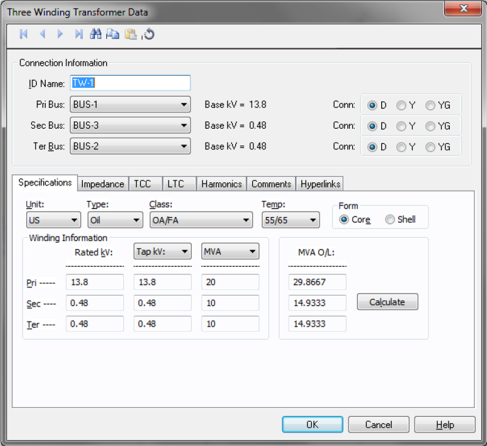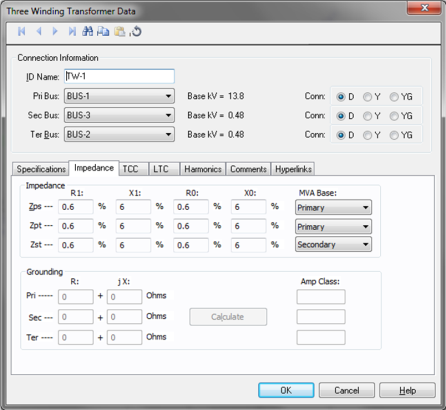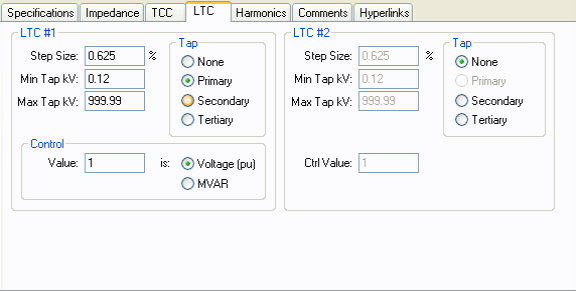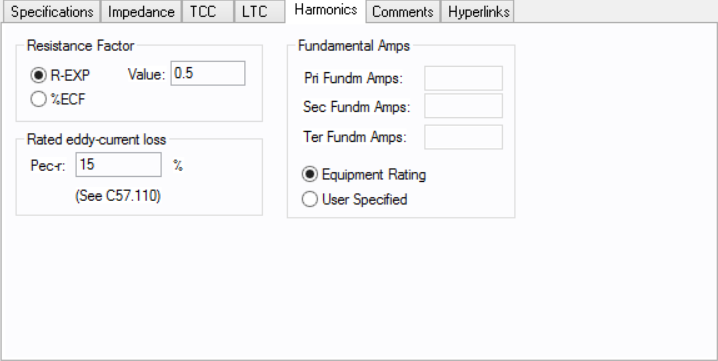
This dialog box includes the following areas and tabs:

Figure 1: Three-Winding Transformer Data Dialog Box
Unit: Choose either U.S. or Metric.
ID Name: Uniquely identifies the transformer. This ID name is sometimes referred to as the transformer name, and can be up to 12 characters long. The names default to TW-1, TW-2, TW-3, and so on as you enter new transformers on the one-line diagram, but you can change those names if needed.
Primary Bus: The bus that is connected to the main transformer winding, or the largest MVA winding. This bus must already exist on the one-line. You must be careful that the Primary Bus has approximately the same base kV as the transformer's Primary Rated kV. (However, EasyPower can model any off-nominal kV rating.) For reference, the Primary Bus base kV is displayed next to the bus name.
Secondary Bus: The bus that is connected to the secondary transformer winding. This bus must already exist on the one-line. You must be careful that the Secondary Bus has approximately the same base kV as the transformer's Secondary Rated kV. (However, EasyPower can model any off-nominal kV rating.) For reference, the Secondary Bus base kV is displayed next to the bus name.
Tertiary Bus: The bus that is connected to the tertiary transformer winding. This bus must already exist on the one-line. You must be careful that the Tertiary Bus has approximately the same base kV as the transformer's Tertiary Rated kV. (However, EasyPower can model any off-nominal kV rating.) For reference, the Tertiary Bus base kV is displayed next to the bus name.
Conn: The transformer winding connection type, which is either "Delta" (D), "Wye Ungrounded" (Y), or "Wye Grounded" (YG). If "Wye Grounded" is selected, grounding impedances can be entered on the Impedance tab in the Grounding section.
Type: Type of transformer (oil, gas, dry, silicone, or vapor). This field is used to determine the rating capacity of the transformer for the power flow overload solution.
Class: Type of cooling used by the transformer. Various combinations of forced air, water and forced oil are available. This field is used to determine the rating capacity of the transformer for the power flow overload solution.
Temp: ANSI temperature rating of the transformer. Various combinations can be chosen and are dependent upon the type of transformer. Dual ratings such as 55/65 increase the overload capability of the transformer by 12 percent.
Form: Either core or shell type transformers can be selected. This value is for reference only and does not affect analysis.
Rated kV: Rated kV of a winding. The rated kV can be different than the base kV or the tap kV. EasyPower automatically adjusts the model to account for different taps, turns ratio and bases you choose.
Tap kV / Tap%: Tap kV of a winding. You can also specify the tap kV in terms of percentage of the rated value. If the actual tap kV is not known, enter the rated kV. Load tap changer control can be used to determine final tap settings if desired. EasyPower automatically adjusts the model to account for different taps, turns ratio and bases you select.
MVA/kVA: Self cooled rating of the transformer. Use to select the unit in MVA or kVA.
MVA OL: The overload rating is based on the temperature and class ratings. It is filled in using the Calculate button or you can type in a different rating.
Transformer impedance is in percent on the self-cooled MVA of the winding and nominal voltage rating. The strict definition is the percent of rated voltage impressed on the high voltage winding to produce rated full load current in the short circuited low voltage winding.
In this dialog box, Zps stands for Primary to Secondary, Zpt stands for Primary to Tertiary, and Zst stands for Secondary to Tertiary.
Manufacturers provide impedance data in many different formats depending on the test facility and transformer size. The data entry format for EasyPower was chosen from one of the most common testing procedures.
You can specify the impedances in any MVA base: the primary, secondary, or tertiary.

Figure 2: Impedance tab of Three-Winding Transformer Data Dialog Box
R1: Positive sequence winding resistance in percent.
X1: Positive sequence winding leakage reactance in percent.
R0, X0: Zero sequence winding leakage impedance in percent. If you don't know this value, enter the positive sequence impedance (Z) for shell transformers (see the Form field on the transformer's main dialog box). For core transformers, use approximately 85% of Z. If you enter this value as zero (0.0), the positive sequence impedance is be used.
MVA Base: The winding MVA based upon which the percent impedance value is specified.
Use the Grounding area of the Impedance tab to enter grounding impedances. They only apply to wye grounded connections. The units are R + jX in ohms. If you only know the ground amperes of the circuit, divide the line to neutral voltage of the circuit by the amperes to get the impedance. This can be achieved in EasyPower by entering the Amp Class first and then clicking Calculate.
R: Transformer neutral ground resistance in ohms. This is the most common method of grounding the transformer neutral winding. Grounding resistors are usually given in amperes. The impedance is found from the following equation.
R = Vln / I
If the transformer is grounded through a grounding transformer with a secondary resistance, this resistance must be converted to the primary winding. Only wye grounded transformers are modeled with grounds. Mid or corner tapped delta windings are not modeled.
jX: Transformer neutral ground reactance in ohms.
Amp Class: This is the current in amps through the ground impedance at the rated voltage. You can enter data in this field directly in Amps or calculate it based on the voltage and ground impedance R +jX using the Calculate button

Figure 3: TCC Tab for Three Winding Transformer Data Dialog Box
Plot 100% Withstand TCC: Select this check box to plot transformer damage curve for 100% withstand. This is without taking into consideration the derating factor for winding connection type and the type of fault.
Plot Unbalanced Derating (58% or 87%) TCC: Select this check box to plot transformer damage curve taking into consideration the derating factor for winding connection type and the type of fault. The transformer curve shifts left by 58% or 87% depending on the connection type.
Use Frequent Fault Curve(s): Select this check box to plot the transformer damage curves as Category II to IV (thermal and mechanical withstand) for frequently occurring faults. The curve shifts towards the left depending upon the transformer impedance.
Standard: The standard according to which the curve is plotted.
Maximum Plot Time: The maximum time in seconds for which the transformer damage curve is plotted.
FLA x: Magnetizing inrush current as multiples of full load amps for the primary winding.
Cycles: Time taken by magnetizing inrush current in terms of number of cycles.
FLA Based on: Calculation basis for full load amps. “MVA O/L” is MVA capacity for overload and “Rated MVA” is self-cooled capacity.
Plot Side: The side of transformer for which the short circuit withstand is plotted. Short circuit is applied on Secondary or Tertiary side. The primary line current is shown in the plot.
Auto-Coordination Setting: Specify whether the protective device is accessible only to qualified personnel (supervised) or unsupervised. This affects the protective device settings based on NEC rules.
Z System: While plotting the transformer damage curve, typical practice assumes infinite source (zero system impedance) on the upstream side of the transformer. You can include the upstream system impedance to lower the maximum fault current that the transformer sees. The system impedance must be converted to per unit impedance on the transformer MVA base.

Figure 4: LTC tab of Three-Winding Transformer Data Dialog Box
Tap: Load tap changers (LTC) can be placed on one or two windings of a three-winding transformer. Any combination of primary, secondary or tertiary is allowed, provided that they do not specify the same winding. Also, if only one LTC is used, it must be LTC #1. If the transformer does not have an LTC, select None for standard fixed taps. Fixed off-nominal taps can be entered in the main dialog's Tap kV field.
Step Size: The default is 0.625 but you can type in your own percentage step size both here and in the power flow three-winding transformer temporary dialog box.
Min Tap kV: Minimum tap kV is used to determine the bottom limit to which the tap can be adjusted during a power flow analysis. This value should be the lowest tap on the transformer to get meaningful results. The default of 0.12 kV is not realistic and should be changed to the actual values if the LTC is used.
Max Tap kV: Maximum tap kV, which is used to determine the upper limit that the tap can be adjusted to during a power flow analysis. This value should be the highest tap on the transformer to get meaningful results. The default of 1500 kV is not realistic and should be changed to the actual values if the LTC is used.
Control Value (Ctrl Value): Control value, which is determined by the Control Type field.
Control Type: Determines how the LTC model is used.

Use the Harmonics tab to indicate whether this equipment item is introducing harmonics into your power system.
EasyPower offers two methods for calculating RH:
RH = RFund * H R-EXP
RH = RFund * (1+ECF*H2)/(1+ECF)
EasyPower defaults all skin effect correction to R-EXP and a value of 0.5.
| R-EXP | %ECF | |
|---|---|---|
|
Transformer |
0.5-1.0 |
1.0-3.0 |
|
Utility |
0.0-0.8 |
- |
|
Generator |
0.3-0.6 |
- |
|
Line/Cable |
0.5 |
- |
|
Reactor |
0.5-1.0 |
0.8-3.0 |
|
Motor |
0.2-0.4 |
- |
Use to set the fundamental amps. The options are as follows:
To use fundamental current calculated by power flow, select Calculated from Power Flow in the Summation Fundamental Voltage area of the Harmonics Options > Control dialog box.
For three-winding transformers, the options are:
Pri Fundm Amps: Calculated rated amps on the primary side.
Sec Fundm Amps: Calculated rated amps on the secondary side.
Ter Fundm Amps: Calculated rated amps on the tertiary side.
Rated eddy-current loss, Pec-r: Eddy-current loss under rated conditions expressed as a percentage of rated I2R loss.
This tab is read-only and appears only if you have imported data from an SKM Data Format file. See Importing an SKM Format File for more information.
See Comments for information.
See Hyperlinks for information.
| Database Technical Reference |